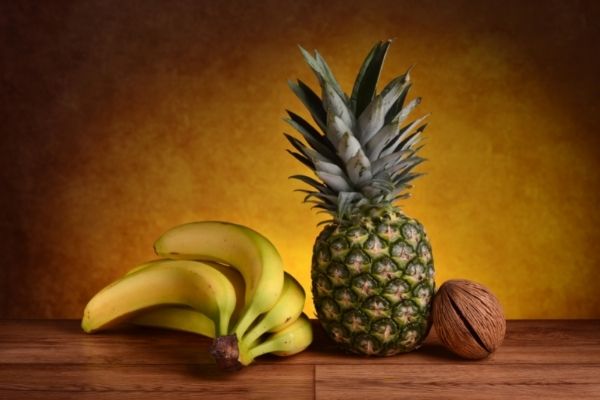Did you know that innovative sustainable fabric is being designed from food waste, in the fashion industry’s continual bid to contribute to a circular economy?
Sustainable fashion is a great way to reduce the impact of the fashion industry on the environment.
If you’re curious about handbags made of pineapple, shorts made of coffee, and dresses made of banana then stick around.
In this article, we run through some of the best eco-friendly fabrics made from food waste.
Benefits of Recycling Food Waste Into Sustainable Fabric
According to the United Nations Environment Programme, the fashion industry is responsible for more carbon emissions than international flights and shipping combined.¹
As the wheels of fast fashion brands keep turning – it is reported that the fashion industry will consume 25% of the world’s carbon budget by 2050.
Looking for ethical fashion alternatives to minimize textile waste, and limit the resources used during the production of clothing is vital for sustainability.
Advantages Of Recycled Food Waste Fabric
- Benefits a circular economy and minimizes food waste and disposal.
- Often biodegradable.
- Natural fiber can be kinder to the skin, and cause less irritation.
- Allows land to be used for food production, as opposed to natural fibers for textile production.
- Each fiber holds unique properties and benefits derived from its originating plant.
How To Turn Food Into Fabric
There are a variety of different ways that plant waste can magically transform into sustainable fabric.
Ultimately it depends on the type of plant being recycled.
Different parts of the plant can be used for creating a recycled fabric such as the stalk, seeds, leaves, or peel.
Circular Systems is a US-based clean-tech company that focuses on sustainability and circular economy. They use a unique process called Agraloop.²
To produce Agraloop BioFibre they collect plant stems and leaves before it is separated and cleaned. The raw material then goes through a period of ‘wet processing’ which results in a chemical reaction that allows the raw material to be dried and spun into yarn.
Agraloop BioFibre can be made into hemp fabric, and other natural fabrics made from raw materials such as bananas and pineapples.
What Food Waste Is Recycled Into Yarn?
Let’s look at a few cool recycled fabrics and materials that are currently on the market.
What Is Banana Fabric?
Banana fabric is a plant-based natural textile. It comes from the stem of the banana plant or its peel.
The concept of using bananas to create eco-friendly fabric has been an age-old practice in Asia, but luckily the mainstream industry has caught on to the benefits of using bananas for sustainable clothing fabric.
The material has different qualities depending on which part of the banana is used. The inner fiber is soft, silky, and delicate. Whereas the outer fiber is coarser more like cotton fiber.
Bananatex is a banana fabric made in the Philippines and is known as the first waterproof banana-based fabric.³
If you’re looking for banana fabric then Milo+Nicki is a beautiful, sustainable brand that stands for authentic living and ethical fashion. Their clothes are biodegradable and they choose to manufacture sustainably.
One of my favorite things about Milo+Nicki is that they focus on minimalism and reducing waste. Meaning that many of their clothes are multi-functional.
Where are my capsule wardrobe ladies? This is for you!
They have a classy floral top made from banana fabric that is suitable for day and night. Yes, day and night.
Many of their clothes are interchangeable and can be seamlessly styled together.
Love, Love, Love.
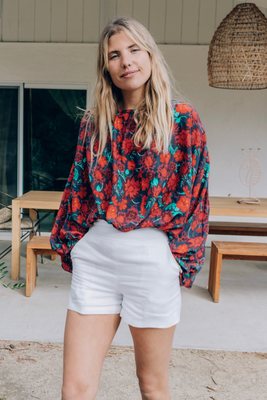
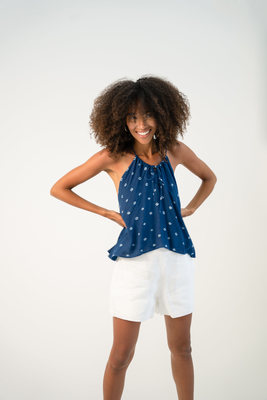
What Is Parblex?
Parblex is a sustainable material that is made from recycled potato waste.
Chip[s] Board is a brand that pioneers the circular economy of potato waste into eco-fashion. Chip[s] Board is a brand that recycles potato waste from McCain chips into a variety of sustainable items.⁴
The waste from chip production is recycled into a bioplastic that is biodegradable and recyclable. They note that Parblex does not contain harmful chemicals, and it is also sturdy and durable.
Parblex is used successfully within the fashion industry for glasses frames and buttons to reduce plastic waste.
Cool hey?
What Is Pineapple Fabric?
Pineapple fabric, also known as piña fabric is another age-old technique that has made its way back into fashion.
Originating in tropical climates, and traced back to places like the Philippines, pineapple has a long history of being used to make different textiles such as silk.
Side note: the Philippines is the OG of sustainable fabrics!
Piña fabric is made from pineapple leaves which are scraped and washed before the fiber is strung out to dry. From there it is dried and knotted into yarn.
You may have heard of Piñatex which is one of the most well-known brands of pineapple fabrics on the ethical fashion market.⁵
Piñatex is pioneering vegan leather made from pineapples. Dr. Carmen Hijosa is the powerful woman behind this innovative sustainable textile fashion brand.
Svala is a great brand that uses piñatex. It was named the Best Vegan Brand Of The Year in 2020 and focuses on ethical, handcrafted, premium vegan handbags.
This sustainable clothing brand is proudly using piñatex, Italian vegan leather, and cork in their sustainable handbag collections. And we cannot get enough of this amazing fashion revolution!
Svala has a mission to bring premium sustainable fashion items to consumers by cutting out the middleman.
Meaning that ethical fashion consumers get access to premium sustainable fashion without the eye-watering price tag.
TheirDidi Clutch Mini – Metallic Black Piñatex is one of my personal favorites because of its versatility.
This lovely gold pineapple fabric clutch bag can be paired with just about anything.
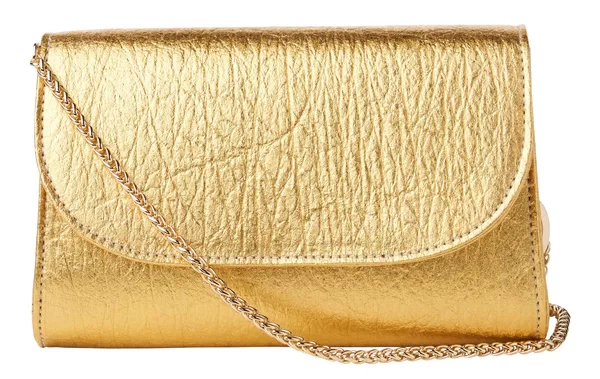
Think white shirt, and upcycled jean cut-off shorts for a daytime summer look.
Or with a cute Milo+Nicki banana fabric dress such as the Indigo Fiesta Dress for a nighttime look.
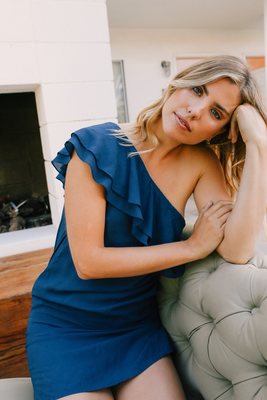
What Is Coir?
Coir is made from coconut fiber.
Coir has been used for centuries, and many countries have traditionally used coir for making ropes.
The outer husk of the coconut is a natural fiber that can be used for a variety of products. It is strong, resistant, and semi-waterproof which makes it perfect for clothing, doormats, paintbrushes, sacking, and upholstery padding.
There are three different types of coir that are used: brown, mature brown, and white. The fiber is harvested at different stages of the coconut’s ripening, which also means that the fiber holds different properties.
Brown coir is the strongest and is obtained from fully ripe coconuts. Mature brown coir is strong but not as flexible as brown coir. And white coir is the weakest variety but is also much softer.
Coir fibers are found between the hard shell and the outer edge of the coconut.
After the fruit has been removed from the shell the coconut is soaked in water for a prolonged period of time. This allows the plant tissues surrounding the coir fiber to break down.
From there the fibers are cleaned, dried, and can be spun into yarn or even dyed.
Vissla is a surf brand that stands for freedom and sustainability within ocean sports.
They use Cocotex for their clothes which is a blend of coconut husk with recycled Repreve polyester. From this blend of coconut fabric and recycled polyester, they make their amazing ethical board shorts.
Coir is one of the only natural fibers that are highly resistant to saltwater damage.
Making coir and Cocotex the perfect ethical fabric option for sustainable surf brands like Vissla.
Coming in a variety of different colors, from floral and funky to earthy and natural tones – you’ll find a style for every occasion 🙂
Recycled polyester is an amazing fabric to use to reduce textile waste, and save plastic from the ocean.
Did you know that recycled polyester is most commonly made from plastic bottles?
Check out our post to get the full breakdown of recycled polyester here.
What Is Coffee Ground Fiber?
The waste from your beloved coffee can be recycled into fabric… Marvelous isn’t it!
S.Café is one of the biggest companies that save coffee from landfills and they partner with many large athletic brands and Starbucks.
They save coffee grounds from waste by recycling them into clothes. S.Café yarn is created by mixing coffee grounds with recycled plastic bottles (recycled polyester). And after processing this is then spun into coffee yarn.
S.Café coffee fiber holds some interesting features such as UV protection, fast-drying properties, odor control, and temperature cooling!
CoalaTree is rocking their sustainable clothing collection with recycled coffee fabric, and I love their Evolution Hoodie.
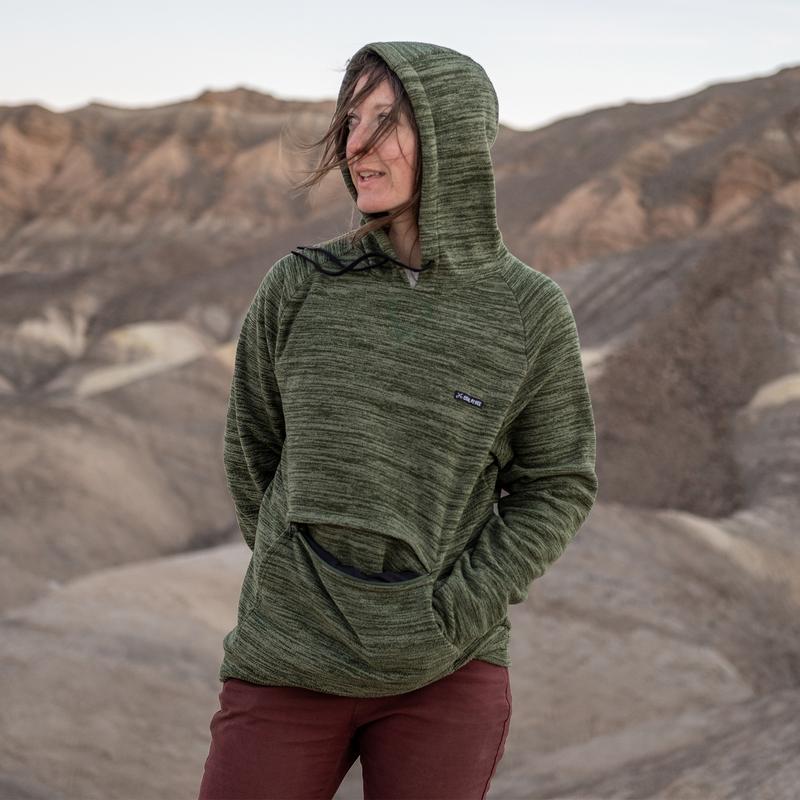
This recycled coffee fabric hooded jumper comes in four different colors and is perfect for loungewear, activewear, or casual everyday wear.
It is odor-resistant and quick-drying, making it perfect for multifunctional active use.
Conclusion
Modern technology means we can create more innovative ways to explore a circular economy.
Finding ways to use food waste for recycled clothing is a smart way to ensure that our global systems are more sustainable and earth-friendly.
Using resources such as food waste is a powerful way to help the environment by creating versatile and ethical recycled materials for the modern consumer.
Let us know in the comments what your favorite food waste recycled fabric is!
Learn more about recycled fabrics in our series:
- Recycled Fabric: The Ultimate Guide to Innovative and Sustainable Recycled Fabrics
- Is Nylon Plastic? Sustainable Guide to Nylon and Recycled Nylon Fabric
- What Is Polyester? | Easy Beginners Guide To Recycled Polyester Fabric
- Why Should We Use Recycled Cotton Fabric? | Easy Guide To Sustainable Fashion
- Clothes Recycling: How to Recycle Clothes Sustainably


